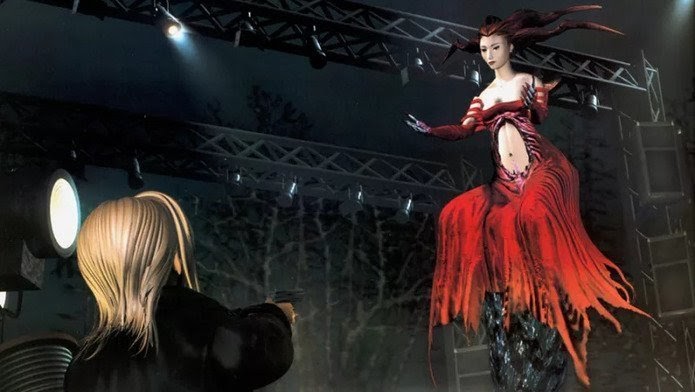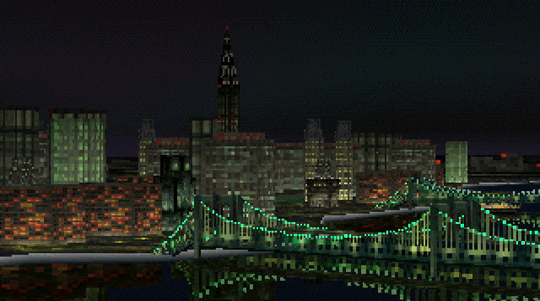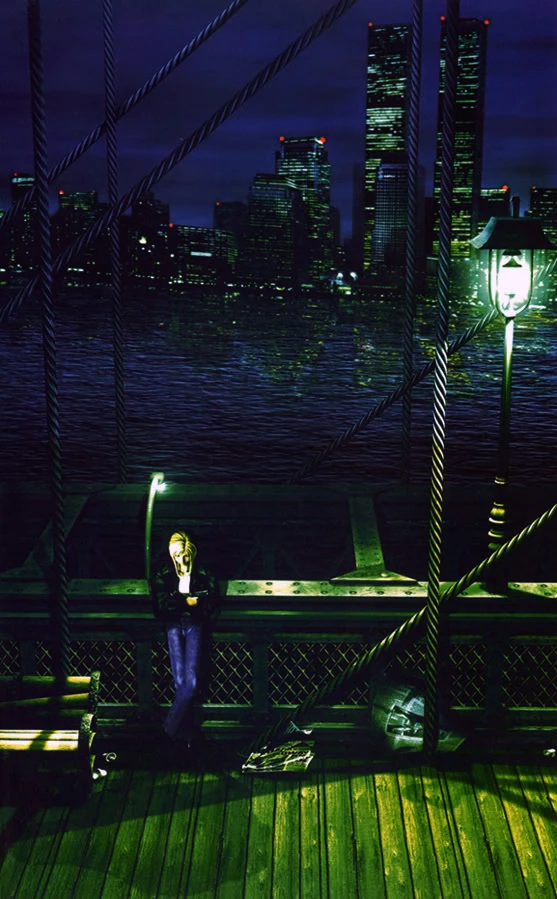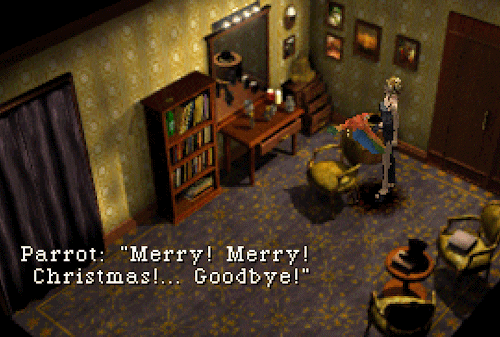


For some reason, I could ask anyone around my age what the ‘powerhouse of the cell’ is and they would almost certainly respond with ‘the mitochondria’. Someone, somewhere wrote the phrase “The mitochondria is the powerhouse of the cell” and it caused a staggering ripple effect that will outlive the biologist tenfold. I draw pictures and choose colors for a living, so I never had much of an interest in biology. I can remember what the powerhouse of the cell is, but I really don’t know what that actually means and I would be willing to bet that most people who can recite that cursed phrase do not really know what it actually means either. Powerhouse.. Cell.. These are words I understand, but how is the power being generated? What is the mitochondria really doing? Again, I am not really THAT interested in biology, so to uncover this mystery, I turned to

Parasite Eve is a genetic smorgasbord of RPG elements, polygonal horror, biological chaos, and a dose of absurdity. The game follows NYPD officer Aya Brea over the course of six days as she accumulates enough guns, items, and biological powers to take down the police department’s greatest enemy: Eve. Now this is where the mitochondria come in — follow along. Eve is a sentient, parasitic life form that evolved from the powerhouse of the cell. These powerful, ambitious mitochondria were passed down through a female line of descent and generated so much power, they were able to take over their host’s body — In this case, an opera singer named Melissa. Is this making sense?

On Christmas Eve 1997, Aya Brea steps out of a limousine at Carnegie Hall wearing a sleek black dress with a slit on one side and platform heels. Aya is on a date and she is going to see the famous opera singer Melissa Pearce. In the middle of the Opera, everybody in Carnegie Hall begins to spontaneously combust except for Aya, her date, and Melissa. The opera singer, whose mitochondria just took over her body, now looks like a monster and is going by the name ‘Eve’. Eve’s goal is to ‘give birth to the next stage of evolution’. She has begun her mission by making everyone in the opera house combust. Aya goes police-mode and confronts Eve, but Eve escapes into the sewers. Mitochondria - 1 | Police - 0
From this point on, Manhattan (metaphorically) goes up in flames. Eve begins terrorizing the city, citizens are evacuating, and Aya is learning everything she can about Eve while trying to stop her. Interestingly enough, the game is a continuation of the events that occurred in the book of the same title written by Hideaki Sena. In the book, a very similar event happened in Japan about 20ish years earlier and Aya & Melissa have a pretty strong connection to that event. If you are into the story of this game at all, I would actually recommend giving the book a read beforehand. I enjoyed reading the book and I think it is necessary to paint the full picture of what is really going on. The dialogue in the game does a decent job of filling you in on the story, but there are some relationships that you can’t quite fully understand without giving the book a read.

The game is split up into six days. Each day is spent hopping around to different locations on this awesome-looking 3D map of Manhattan, usually with Aya and her police partner, Daniel. The player searches for information on what Eve actually is and how to defeat her as well as clues to where her next appearance might be. Then, once Aya knows where Eve is that night, she gears up at the police station and heads out to try and stop her. The meat of the game happens on these nightly hunts for Eve. As Aya, the player walks around notable Manhattan locations such as Central Park and enters random encounters with mutated, mitochondria-crazed animals & bugs. The combat is turn-based, but it is an active time battle system. You need to move Aya around the battlefield and dodge enemy attacks while a meter fills. Once the meter is full, you need to position yourself and choose an action - attack or parasite skill. Attack will have Aya shoot the enemy while a parasite skill uses Aya’s parasite energy in exchange for a special effect or attack. Parasite skills are essentially this game’s magic system. While traversing these areas, Aya typically finds more clues about the mitochondria uprising and the nights ends with a battle against Eve or one of her creations.

Parasite Eve is a really amazing game. The story can be a little obtuse, but the gameplay and visuals more than make up for it. I don’t think any other game developer in 1998 could have pulled this game off as well as Squaresoft did. Known for their turn-based RPG systems and their attention to detail in all things graphical, Squaresoft hit a bullseye with Parasite Eve. There is some seriously gross body horror in this game, though — so if you are squeamish, you may want to skip some of the cutscenes.
Combat mechanics in this game are extremely unique, but not very in-depth. That said, the game takes around 9 hours to complete so the relatively shallow combat mechanics stay fun the entire way through. The mood and atmosphere of this game is incredible. At the time of writing, the game was released 25 years ago and even in 2023, very few games have been able to achieve the level of ~vibe synergy~ that Parasite Eve has. To give you a better idea of what I am talking about, here are a few example of games I consider to have ~vibe synergy~: Bioshock, Dark Souls, Half Life, Hotline Miami. Hopefully you can see the connection.
One of the coolest things about this game in my opinion has got to be the spaces you are actually fighting in. When a random encounter starts, instead of transitioning to a standard battlefield area, you instead fight right on the screen the encounter started in. Meaning you might be in combat in the middle of a snow-covered maze of trees in Central Park or on a balcony on the third floor of the Museum of Natural History. It is a really unique piece of this game that I was thoroughly impressed with.
All in all, Parasite Eve is a perfect short-JRPG. If you are in the mood for a unique JRPG combat system, but don’t want to dive into a 100-hour game, This might be the game for you. You have to be alright with a few things for the game to click (horror, low poly graphics, turn based combat), but if you are at all interested in giving the game a shot, I would endorse it 100%. Coming in at under 10 hours, this game is pretty hard to walk away from as well. If you finish the game and still want more, there is a new game+ mode where you can play through the game with all your items and also climb the Chrysler Tower, where there are boss fights on every floor. The game also has a sequel on the PSX and then another sequel on PSP called “The 3rd Birthday’.

Philip Siekevitz really wasn’t kidding around when he called the mitochondria the ‘powerhouse of the cell’ in 1957. I guess if you let mitochondria evolve too much, they can really cause some destruction. Melissa Pearce’s mitochondria just took over her whole body and basically destroyed Manhattan…
Okay, if I am being honest, I didn’t really learn that much about mitochondria from Parasite Eve, but I’m sure all the pertinent information must be in the sequel.




"Resident Evil WHO?"
"More games need maps like this"


"They don't make 'em like this anymore"


"The vibe is tangible"
"I just don't care about mitochondria"

The room is dark and a little cramped. Bottles, wires and pieces of paper full of furious scribbles litter every surface high and low, and the only sign of life is the smoke rising from a small ember nestled in a pipe. The eyes it illuminates have seen very little but the ears on either side of those eyes have heard the abyss and felt its song. Between those ears is a mind that remembers when life was simpler. When all it had to do was think of some fun clever wild west jokes, point out some highlights, give a few honest jabs at criticism and call it wrapped. A mind that remembers life before the Parasite Eve OST.
When I write these reviews I do a good bit of research on the games and even watch some gameplay before sitting down to put words to screen, usually after i've heard the OST mind you. I also usually listen to it while I write to truly immerse myself in the mood being offered by the music and all these factors continue to prove to me how important the music in a game is. This fact really shines in a game like Parasite Eve as the mood is already heavy and the music adds so much to that weight. The actual listening experience was a bit of a rollercoaster though. I'll start with the highs which were VERY high. "Theme of Mitochondria" is a lowkey powerhouse of melodic percs glued together with a beautifully simple synth line and little glittering electronic accents dancing in the peripherals. Almost a techno touch to the track. Carrying that techno torch is "Arise Within You" which immediately caught my attention as standout tonal shift in the soundtrack up until that point. It also gave me slight Monkey Ball vibes which influenced my biased love greatly and might have possibly maybe caused a Monkey Ball break in the middle of listening, I am just a man. "Out of Phase" slows things down a bit in tempo but ramps things up in layers and structure with a crispy snare line and watery wood melody giving an almost jungle feel to this otherwise urban setting.
The moments that stick to a simple piano line and heavy atmosphere like the "Memory" tracks or "Wheel of Fortune" carry my interest no matter how long they run however the strongest emotional reaction I had throughout the entire runtime was to "Kyrie". What a beautifully arranged track from the composer of this downward spiral of a soundtrack Yoko Shimomura. She is probably best known for her work on the Kingdom Hearts series but Parasite Eve appears to be her real breakout on the game music scene despite having also worked on Super Mario RPG two years prior. Shimomura opens the doors to the cathedral on "Kyrie" and walks you down the black aisle to what sounds like your doom while haunting vocal synthesis reminds you its not just spirits in attendance. This "voice" is used frequently throughout the tracklist sometimes to its detriment, and while that remained my opinion throughout I did grow more accustomed to it as its appearances increased. I believe its the one ingredient that aged the poorest out of all the ideas here and I, myself, almost spontaneously combusted a few times early on when it vibrated onto the mix.
Deeper into the rabbit hole the horror seems to give way to some more dark deep techno jams, my personal favorite of this stretch being "U.B" with its rythmic chants and organ arpeggios. Even the criminally short "Escape From U.B" goes just a bit crazier than it needed to and I had to stand up to really feel that one out (had to run it back a few times too). The one and only fully produced vocal track "Somnia Memorias" rounds the whole experience out near the end of what feels like all things, soulfully sung with some surprisingly rocking guitars riffing throughout. In full the entire listening experience is very eclectic spanning an array of dark, moody jams with a wild and industrial twist that still feels very natural in execution. Having been to NYC multiple times I can confirm this is what plays on the train as you near the city and things start to get a little hot.
-Brandon